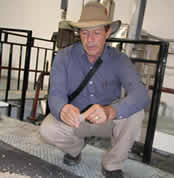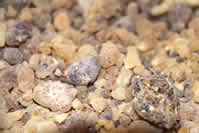Frankincense in Kenya and Oman
A note from Gary Young:
Over the past five weeks I have traveled around the world one and a quarter times, visited 11countries, experienced 36 hours of time zone changes, and took 30flights to see our oil in production and meet with some of our partners in growing and distilling essential oils. They appreciate my personal visits and I had the opportunity to spend much time with them. They have great admiration for the mission of Young Living and respect for my 27 years in the industry.
A highlight of the recent trip was inspecting frankincense sources. We traveled to Nairobi, Kenya, where I was able to introduce Marc Schreuder and Mary Lou Jacobsen to our frankincense suppliers. The final leg of our journey brought us to Oman—home to the famed Frankincense Trail. There we were privileged to explore the historical route and felt blessed to traverse such sacred ground. Interestingly, some companies claim
they are purchasing frankincense harvested in Oman, but if they would travel there themselves, they would discover that frankincense is not commercially harvested in Oman and there are no frankincense distilleries currently in operation there. Upon talking with Omani resin brokers, they explained that the resin they export commercially is harvested in Somalia and Ethiopia and then shipped to England for distillation.
In the following blog post, Marc Schreuder will recount some of our experiences in Nairobi, Kenya, where we were privileged to witness grade-A frankincense (Boswellia carterii) being distilled. There we were able to once again verify the purity of raw materials and the masterful process that produces our Young Living frankincense. There is much more to say but my time is short, please check back often for updates on my travels.
Mary and I send love and appreciation to all,
Gary Young
Frankincense
Located in Kenya is a frankincense (Boswellia carterii) distillation operation which collects resin from the coastal hills of Puntland, a region in northeastern Somalia, and extracts it in a state-of-the-art stainless steel plant near Nairobi, Kenya. The distillery is owned and operated by Dr. Haq and Dr. Osman, a Kenya native and Somali exile. They have joined together to produce one of the best frankincense essential oil distilleries in the world. Moreover, their passion for natural medicine and frankincense is awe inspiring.
Gary Young, MaryLou Jacobson, and I, Marc Schreuder, were recently on hand at the Nairobi facility to watch the steam vessel—loaded with 90 kilos of grade-A resin frankincense freshly collected from Puntland tribes people—undergo a 10-hour distillation process. It was eye-opening to witness how different the distillation of frankincense resin is compared to that of traditional herbs such as rosemary and thyme.
“The resin must have certain moisture content before steam is applied,” emphasized Dr. Osman, who has a PhD in chemistry and more than 20 years of experience in the field. “This is absolutely critical in order to produce a top-grade frankincense essential oil. And the resin must be agitated during distillation to ensure uniform steam dispersion and oil extraction.” Moreover, the separation of the oil from the floral water is even more challenging. “The steam must pass through a series of chillers and receivers to obtain proper oil separation,” stated Dr. Haq. “If separation is not performed precisely with the correct sequence and temperature, valuable components of the frankincense oil will be lost.”
I asked Dr. Haq about organic certification for their frankincense essential oil and she replied that while certification is less than a few months away, this is not a pressing concern. “Almost all frankincense resins are wild-crafted and therefore ‘organic.’ Being organic is the least of our worries.” I was surprised to hear this.
“Raw material variability is always a challenge,” Dr. Osman pointed out. “And the worst type of variability is adulteration. For example, many frankincense suppliers mix in resins from related species such as Boswellia papyrifera and bill the blend as ‘pure Boswellia carterii.’ While the Boswellia papyrifera resin is a beautiful amber and translucent it produces only a small yield of inferior-grade oil. Sometimes up to 20 percent of a sack labeled as Boswellia carterii resin may be a jumble of dirt, debris, and distantly related species.”
Fortunately, the Boswellia carterii resin purchased by Dr. Osman and Dr. Haq is carefully inspected prior to distillation. They rarely find problems because of their policy of only dealing with trusted tribal sources that have longstanding ties to the community and an impeccable history of wild-crafting high quality raw materials. Dr. Osman avoids buying resins in open markets or bazaars where adulteration with bark, dirt, fillers, and unrelated resins is always a risk.
“European tourists to Africa and Arabia are easy marks for buying so-called ‘frankincense’ resins that are actually blends of Boswellia papyrifera and other species,” Dr. Osman noted. “They obtain these resins from local merchants or peddlers, take them home, and show off this ‘frankincense’ to their friends.”
And it is not just tourists who are fooled. Many wholesale buyers from America or Europe buy up inferior grade frankincense essential oils and never know the difference. They have almost no knowledge of gum resin varieties and have never personally inspected the gum resin before it is processed by distillers thousands of miles away.
The problem is that frankincense resin is almost never distilled in the country in which it is harvested, such as in Somalia where violence and political instability are rampant. Instead, bags of resins are exported from Bossaso to other locations where they may be mixed and extended before being shipped off to anonymous third-party distillers in Europe or India who have little interest in guaranteeing raw ingredient integrity. As long as these frankincense essential oils pass an organoleptic review and even Gas Chromatography analysis, they are labeled as 100 percent pure Boswellia carterii frankincense. Unfortunately, these low-grade substitutes are light years from a true therapeutic-grade frankincense essential oil.
Interested in frankincense oil?
– Learn more about Young Living’s frankincense essential oil
– Find out how you can get FREE frankincense oil from Young Living







Would you like to share your thoughts?
Your email address will not be published. Required fields are marked *